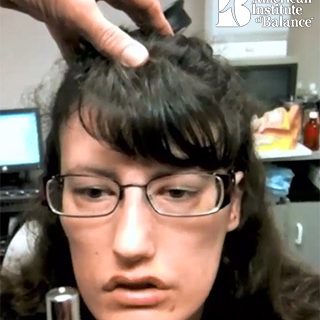
VIDEO – Vestibular Assessment of Patient with Mobius Syndrome Phobic Postural Vertigo: Part I
Published on: September 16, 2014
Mobius Syndrome is a rare congenital genetic disorder involving underdevelopment of cranial nerves VI and VII. Mobius includes aspects of facial paralysis and inability to have patterns of facial expression. Since the majority of classic vestibular assessment protocols e.g. VNG, Vorteq, Rotary Chair utilize the VOR, how then do you evaluate a patient for vestibular function when there is not horizontal eye movement?
Phobic Postural Vertigo is a somatoform disorder that manifests as transient episodes of staggering and grasping for fixed or stationary surfaces, an obsession with one’s own balance function and fear and anxiety of falling or inability to independently ambulate. It may be seen in individuals either with or without a prior history of a vestibular event.
Case Study: Part I
In this video, you will the initial examination of a 38-year-old female with Mobius Syndrome. As noted there is the inability for volitional or involuntary horizontal eye movement. She is able to control eye movement vertically. You will also see a slight left facial paresis. The patient had experienced a single acute and debilitating episode of vertigo lasting 1-2 hours without any auditory or focal neurologic symptoms. She was sent to physical therapy for vestibular therapy but was given primarily gaze stabilization exercises. Obviously with Mobius, this is an ineffective management strategy. Complicating this is the development of an ataxic gait with staggering, inability to ambulate unassisted and obsession with postural control.
The question then is, is there an uncompensated vestibulopathy or is the balance issue merely a psychogenic overlay? Based on limitations imposed by the Mobius, AIB tests of choice were c-VEMP and postural stability tests. If advanced testing e.g. Posturography is unavailable than basic but sensitive tests such as Gans Sensory Organization Performance including; Clinical Test of Sensory Integration of Balance (CTSIB) or Fukuda tests (be sure to test-retest Fukuda) are highly reliable. In this case, all tests were normal suggesting there was no residual effect of the neuritis, which agreed with the absence of any subjective motion or gravity provoked symptoms.
Take Home Message:
- What is the next phase of treatment? More VRT?
- Why ataxia but no other symptoms typical of an uncompensated system?
- Is this all psychogenic?
Watch for PART II: Treating Postural Provoked Vertigo in a Mobius Syndrome Patient
References:
www.ninds.nih.gov/disorders/mobius/moebius.htm
Brandt, T. Phobic Postural Vertigo, Neurology, June 1996 vol. 46 no. 6 1515-1519